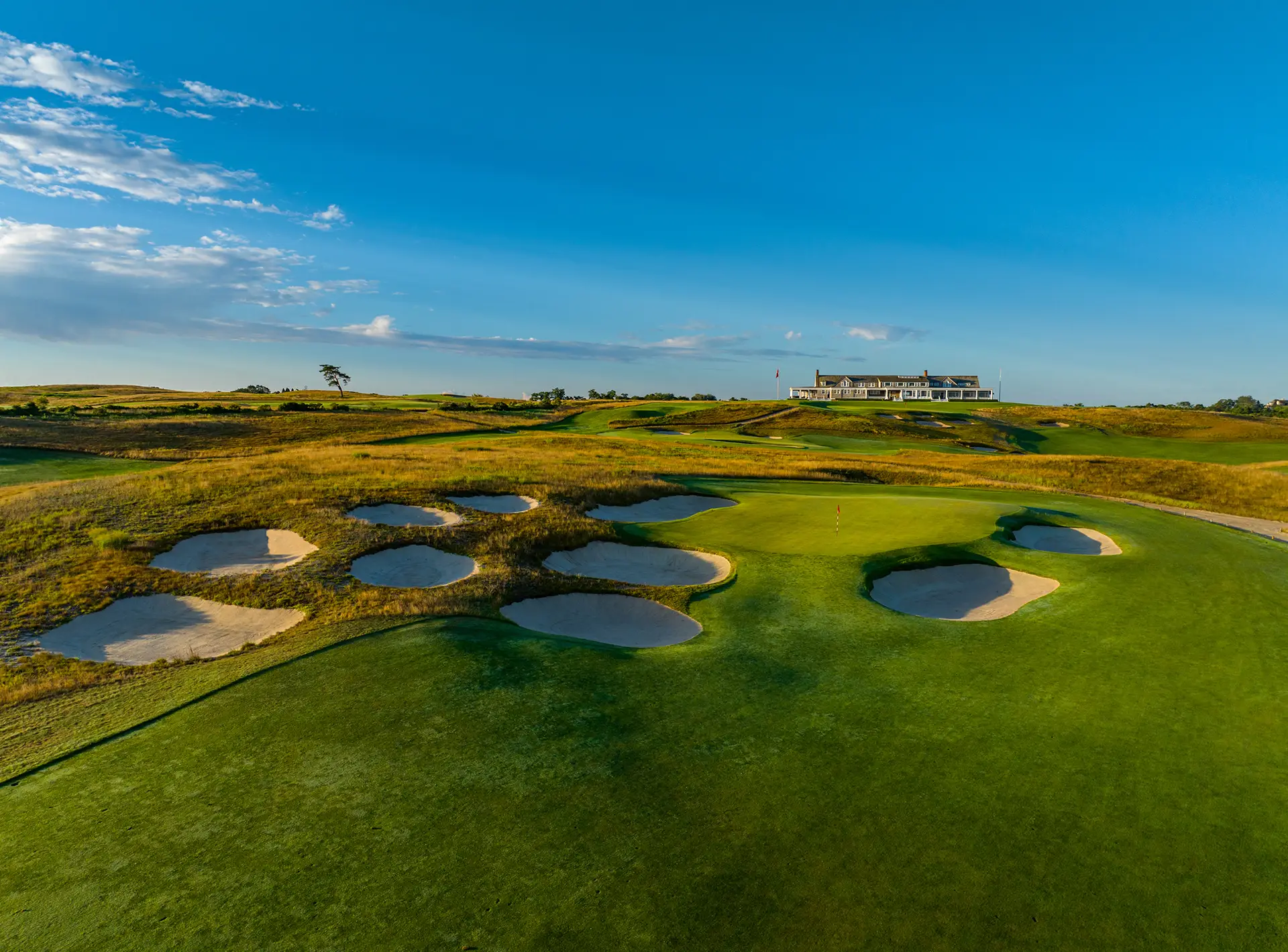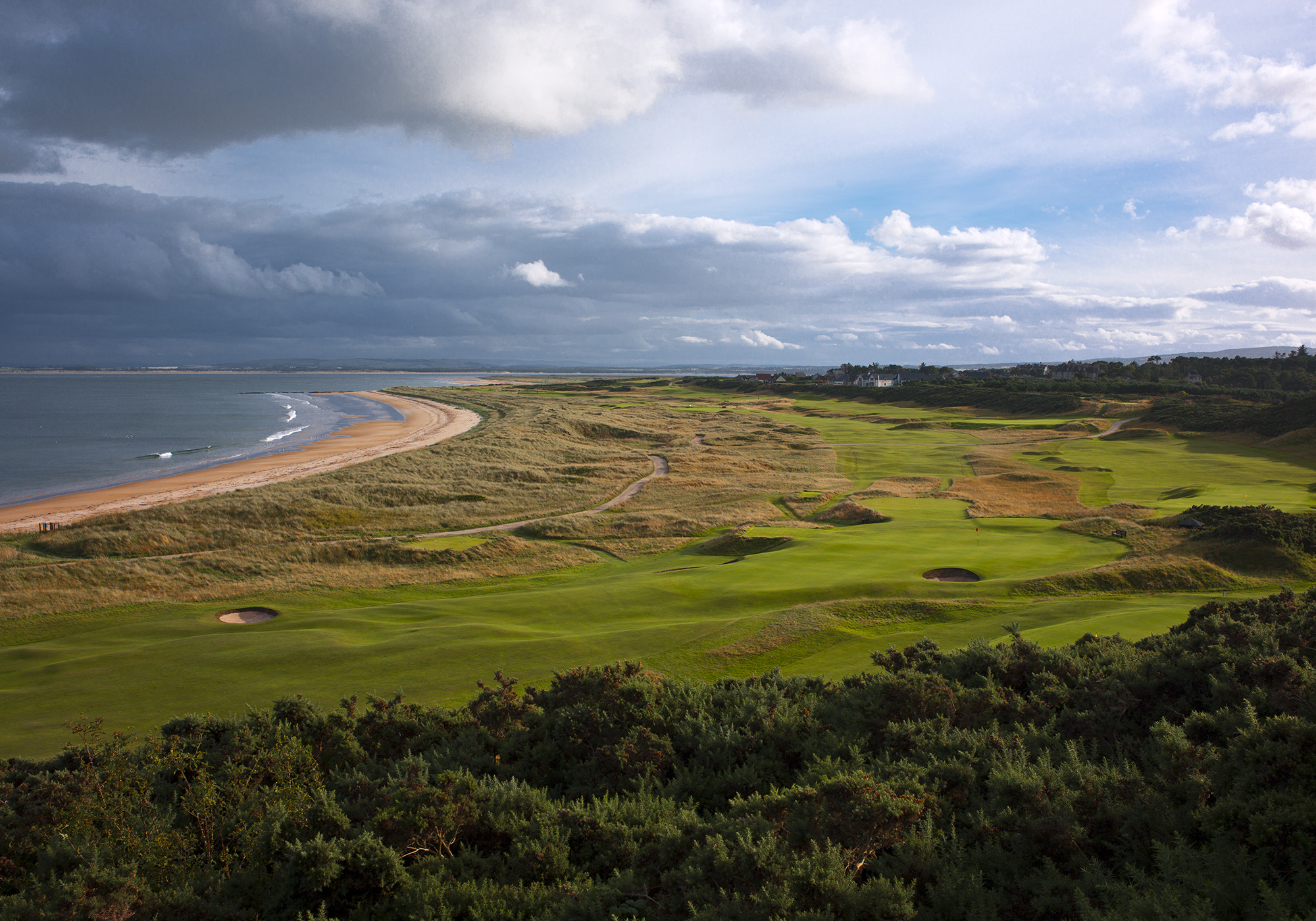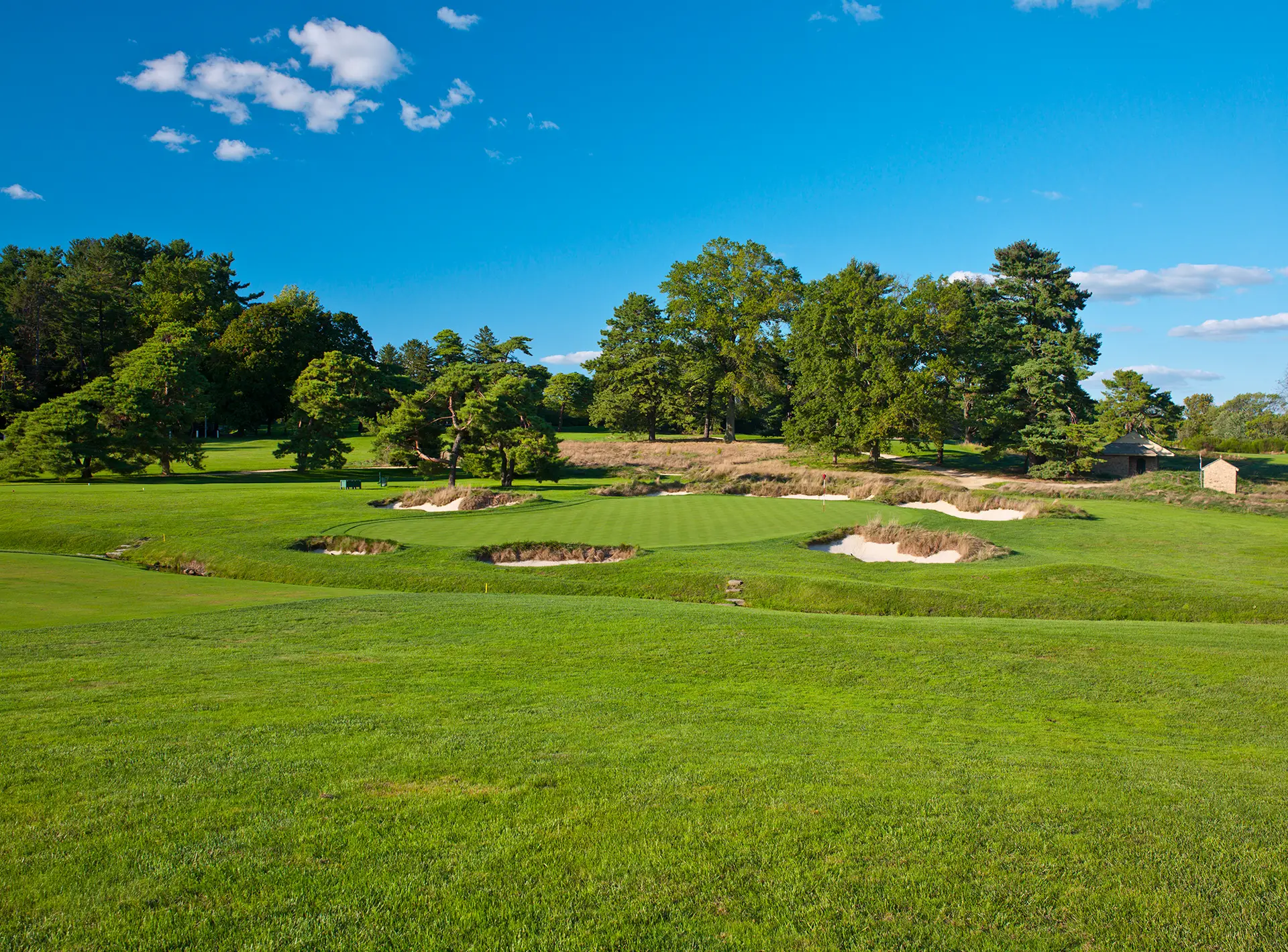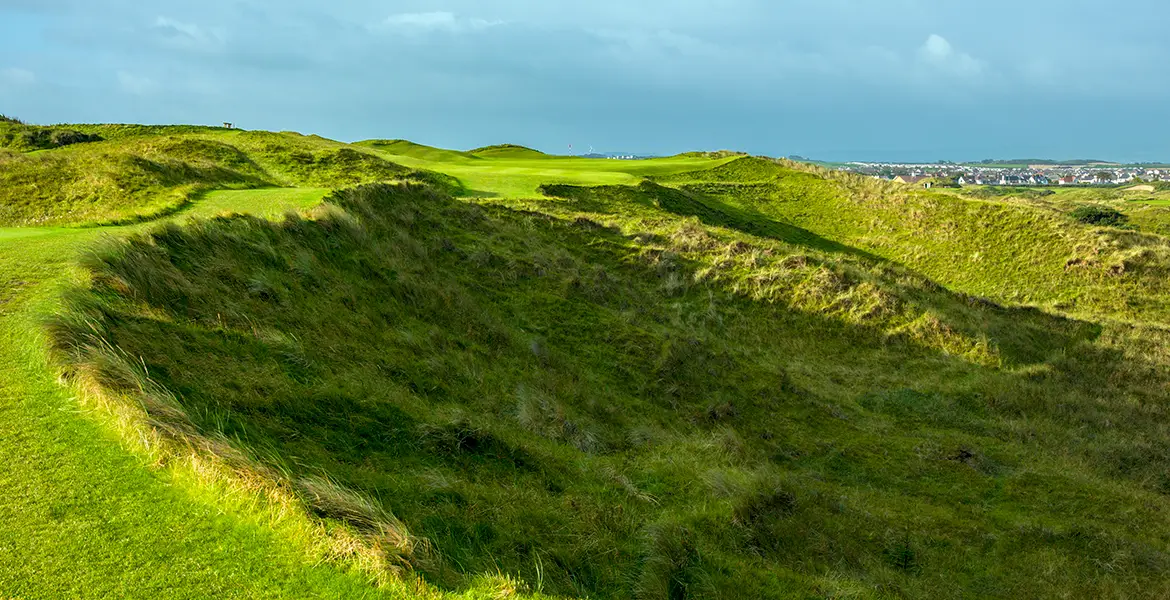The LINKS 100—the 100 best courses in the world as voted on by the architects of the ASGCA, EIGCA, and SAGCA—is replete with outstanding creations designed by the industry’s greatest craftsmen. Some of these courses, however, arrived at the layouts we know today thanks to invaluable inputs from architects who aren’t formally acknowledged.
Here are five mystery architects of The LINKS 100, men who lent their talents to the current design, but whose contributions don’t show up in the official credits.
Shinnecock Hills (Southampton, N.Y.)—LINKS 100 Ranking: 6
Mystery Architect(s): C.B. Macdonald and Seth Raynor
Host to five U.S. Opens, with a sixth on the way in 2026, Shinnecock Hills is a 1931 William Flynn design, one that several sources erroneously misidentified as a Dick Wilson creation. Wilson was on hand to build the course on behalf of the Toomey & Flynn design firm—as labor foreman, under the direction of construction superintendent (and future architect) William F. Gordon—but Shinny was clearly Flynn’s design. Nonetheless, of the multiple architects that revised Willie Davis’s and Willie Dunn’s 19th century design after 1895, only C.B. Macdonald and Seth Raynor’s contributions can be seen on today’s course. Current holes 3, 7, and 9 closely hew to their Macdonald/Raynor versions. Flynn did change the bunkering on all three holes, but he retained the MacRaynor layouts, notably at the uphill, 485-yard par-four 9th, which was Macdonald and Raynor’s 18th from 1916–31.

Royal Dornoch, Championship (Dornoch, Scotland)—LINKS 100 Ranking: 10
Mystery Architect(s): Donald Ross
Dornoch first hosted golfers in 1616, though the golf course we know as Royal Dornoch began with nine holes in 1877. In the late 1880s, the club turned to the ubiquitous Old Tom Morris to refine the existing nine, then add nine additional holes. Old Tom secures the solo design credit for Royal Dornoch, but much has changed since his heyday. Club Secretary John Sutherland, a member since 1881, paired with five-time Open champion J.H. Taylor to modify many holes, primarily from 1904–07, when Taylor vacationed there in the summer. Sutherland designed the par-five 12th, a hole that is named for him. Another significant alteration came courtesy of Donald Ross, who grew up in Dornoch and who served as the club’s head greenkeeper from 1895–98. After carving out a successful career as an architect in America, Ross returned to Dornoch for a summer visit in 1921, when he mapped out replacements for the 280-yard 1st hole and the 250-yard 2nd hole. His new holes weren’t approved until 1927 and were finally built in 1928, most notably, the 190-yard par-three 2nd.

According to many scholars, the club tabbed Scotsman George Duncan, the 1920 Open Championship winner, to craft six new holes after World War II (today’s 6 through 11) to replace holes that had sat on land requestioned for military use and to accommodate the siphoning of holes that went to the club’s Struie course. Interestingly, the club itself credits Duncan for just two new holes, the 7th and the 8th, but states that ideas for those holes were likely suggested by the club’s greenkeeper and head professional, Robbie Grant. Finally, over the past 10 years, Royal Dornoch enlisted Tom Mackenzie of Mackenzie & Ebert to effectuate changes at holes 5, 7, 8, 10, 11, and 12. Most prominently, Mackenzie created a new 7th hole in 2020, one perched closer to the edge of the ridge that divides sections of the course, and which seamlessly replicates the green of the old 7th.
Pebble Beach Golf Links (Pebble Beach, Calif.)—LINKS 100 Ranking: 15
Mystery Architect(s): Alister MacKenzie
Well known is the story of how Pebble Beach founder Samuel F.B. Morse tasked novice architect Jack Neville to design his new oceanside golf course in 1915. Neville, a California Amateur champ, enlisted fellow amateur great Douglas Grant to assist, especially in the bunkering, and Pebble opened for play in 1919. Their original design didn’t last long. In 1922 Herbert Fowler memorably transformed the weak, if scenic, par-four 18th into a strong, spectacular par five. Less well known is that Alister MacKenzie is part of the design tapestry at Pebble. In 1926–27, on the heels of creating the Meadow Club north of San Francisco and starting work on Cypress Point, MacKenzie rebuilt the green complexes on Pebble’s 8th and 13th holes. The green at the 8th stands out for its cliffside setting and its magnificent bunker framing.

In 1928, MacKenzie’s then design partner, Robert Hunter, teamed with 1904 and 1905 U.S. Amateur champion Chandler Egan to rework a fistful of holes ahead of the 1929 U.S. Amateur. Among their most prominent alterations were relocating the first tee, changing the hole to the dogleg we know today, and moving the green at the par-four 16th hole to the far side of a natural hollow, one now filled with sand—which extended the hole by 100 yards. Pebble’s final major design tweak occurred in 1997, when Jack Nicklaus created a new par-three 5th, on newly acquired oceanfront land.
Merion Golf Club, East Course (Ardmore, Pa.)—LINKS 100 Ranking: 18
Mystery Architect(s): William Flynn
Club member Hugh Wilson famously designed Merion’s East course in 1912, following an extensive tour of the top courses in Scotland and England. After completing his initial layout, Wilson continued to be the architect in charge of subsequent course changes, until his untimely death in early 1925. During the final 10 years of his life, however, he was ably assisted by William Flynn, who was first hired at Merion as construction superintendent for the 1912 layout, then stayed on for several years as superintendent. Flynn, with remarkable foresight, scored a federal patent for Merion’s wicker basket flagsticks in 1915.

By most accounts, Flynn worked alongside Wilson whenever a design feature was altered, but following Wilson’s passing, he effected design changes on his own. One of the most noteworthy fixes occurred at Merion’s short par-four 10th. In Wilson’s day, the green was located across Ardmore Avenue from its present location. In that era, though, Ardmore Avenue wasn’t even a road, recalled architect Tom Marzolf, who renovated and restored the East course with Tom Fazio ahead of the 2013 U.S. Open. When the road was put in, the routing had to change and several holes had to change, said Marzolf. Credit William Flynn for making those changes, including relocating the green at the 10th.
Seminole (Juno Beach, Fla.)—LINKS 100 Ranking: 65
Mystery Architect(s): Dick Wilson
This posh coastal retreat designed by Donald Ross challenges with palms, sea grape bushes, ocean breezes, and a varied routing that encompasses two dune ridges. So impressed was Ben Hogan with Seminole’s virtues that he would play and practice here for 30 straight days each year leading up to the Masters. Seminole was on the short list of Ross’s true masterpieces, but World War II wasn’t kind to the course. As with many courses of the day, including Augusta National, it didn’t see much action as a golf course during the war years, almost to the point of disrepair. To bring the course back from the brink, the club quietly enlisted Dick Wilson, an up-and-coming architect who was based in Florida to revive the layout.

Course connoisseurs and insiders disagree to this day about the extent of Wilson’s involvement, since he received no credit, but undeniably he reworked bunkers—their position and shaping—and he most certainly changed the par-four 18th hole, relocating the green from its old position where today’s practice range sits and shifting it to the left where it edged the dunes. He is likely also responsible for moving the 18th tee from the right of the 17th green to the left of it, transforming the 18th into a dogleg left. Bill Coore and Ben Crenshaw restored much of the course from 2018–21, and one day soon, Gil Hanse’s team may have a go at a more complete restoration. But only the semi-forgotten figure of Dick Wilson—architect of such courses as Doral’s Blue Monster, Pine Tree, La Costa, Bay Hill, NCR (South), Royal Montreal, and Cog Hill No. 4—actually changed the design at Seminole.





